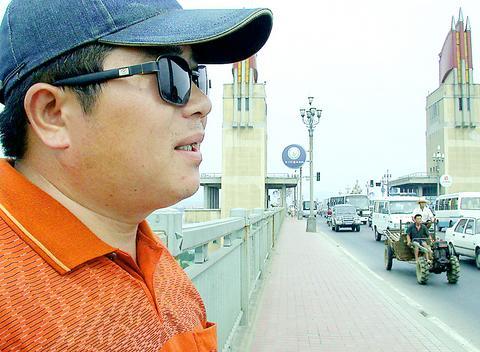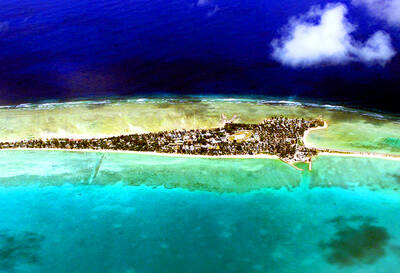Since Chen Si started patrolling for suicide jumpers on Nanjing's Yangtze River Bridge some 10 months ago, he has seen three people willfully leap to their death.
"I saw one young woman whose body was curled up like a baby's and she was holding her head in her arms as she jumped. I grieved for her for quite a long time," Chen said quietly.
Donning a well-worn baseball cap and large black sunglasses to protect himself from the scorching summer temperatures that can hit 50?C on the bridge, the self-appointed volunteer arrives every weekend at 8am.

PHOTO: AFP
He stays until sunset and if he's lucky no one will try to take their lives, but that is almost never the case.
"Women are easier to deal with," said Chen, his eye scanning the bridge's expansive 4,589m that cross China's mightiest river.
"You can talk to them and try and get them to cry out their pain. The men, I usually tackle them because they seldom listen and they can be very strong," he said, adding that once one determined male almost took him over the edge.
Although no one in this river-port city refers to it as the "suicide bridge," the name would be apt. Every Saturday and Sunday in this bustling eastern metropolis of six million, three hours by train from Shanghai, somebody comes here to die.
The bridge was completed in 1968 and was celebrated as a feat of Chinese engineering when it won a place in the Guinness Book of World Records as the longest highway and railway bridge. Today it has more notoriety for being a sure-fire place to kill oneself.
With a drop of 100m to the river below, the nine-second fall from the top will shatter human bones, while the cold yellow waters of the Yangtze are sure to do the rest.
For Chen, the bridge's length means it is impossible to safeguard both sides, so if someone is preparing to go over the chest-high fence on the north end there is nothing the stocky and leather-tanned 37-year-old can do.
Fortunately, most approach from the south, and among the din of traffic exhaust fumes, are then met by a yellow flag and an accompanying billboard which pleas with visitors and the suicidal alike to give life one more chance.
It reads: "Maybe you feel tired, maybe you think this is the end of the world, or maybe you have been wronged -- but life comes only once, so please give yourself one more chance because tomorrow the sun will bring something new."
During his time as the bridge's Good Samaritan, Chen has stopped 40 people from jumping, although he recognizes he cannot get to everyone.
"I've only got a pair of hands, but if I can save one life then that's one life," Chen said.
He says he does what he does simply because he feels compelled to help, drawn to the bridge after noticing a growing number of suicides in the local media.
"Now, almost 24 hours a day, I get telephone calls from people all over the country, telling me that they want to die and asking for help," he said.
At the Nanjing Yangtze River Bridge over 1,000 people in total, or an average of 27 people a year, are estimated to have intentionally plunged to their deaths.
In China, home to a fifth of the world's population, this is just the tip of the iceberg. The country has never imbued suicide with the same sinful opprobrium seen in the West, but instead often embraced it as a way of preserving honor and proving moral purity.
According to statistics published in official media last November, China accounts for a quarter of the globe's suicides with 280,000 people killing themselves every year.
Suicide is the leading cause of death in the 15-34 age bracket in China, the only country in the world where the rate for females is higher than for males. Doctors have been unable to explain why mainland Chinese females are almost three times more likely to try to take their lives than males, although one explanation may lie in cultural tradition, they say.
Chen says it is data like this that has driven him to the bridge to help, brushing off accusations that he is only seeking money and fame.
"Someone had to take action," said the small shop owner who has seen his share of hardship after his mother abandoned him at the age of six.
"All I want to do is to give those desperate people some hope."
Asked how long he would keep up his vigil, the father of one replied: "Until I can't take it any longer."

DISASTER: The Bangladesh Meteorological Department recorded a magnitude 5.7 and tremors reached as far as Kolkata, India, more than 300km away from the epicenter A powerful earthquake struck Bangladesh yesterday outside the crowded capital, Dhaka, killing at least five people and injuring about a hundred, the government said. The magnitude 5.5 quake struck at 10:38am near Narsingdi, Bangladesh, about 33km from Dhaka, the US Geological Survey (USGS) said. The earthquake sparked fear and chaos with many in the Muslim-majority nation of 170 million people at home on their day off. AFP reporters in Dhaka said they saw people weeping in the streets while others appeared shocked. Bangladesh Interim Leader Muhammad Yunus expressed his “deep shock and sorrow over the news of casualties in various districts.” At least five people,

It is one of the world’s most famous unsolved codes whose answer could sell for a fortune — but two US friends say they have already found the secret hidden by Kryptos. The S-shaped copper sculpture has baffled cryptography enthusiasts since its 1990 installation on the grounds of the CIA headquarters in Virginia, with three of its four messages deciphered so far. Yet K4, the final passage, has kept codebreakers scratching their heads. Sculptor Jim Sanborn, 80, has been so overwhelmed by guesses that he started charging US$50 for each response. Sanborn in August announced he would auction the 97-character solution to K4

SHOW OF FORCE: The US has held nine multilateral drills near Guam in the past four months, which Australia said was important to deter coercion in the region Five Chinese research vessels, including ships used for space and missile tracking and underwater mapping, were active in the northwest Pacific last month, as the US stepped up military exercises, data compiled by a Guam-based group shows. Rapid militarization in the northern Pacific gets insufficient attention, the Pacific Center for Island Security said, adding that it makes island populations a potential target in any great-power conflict. “If you look at the number of US and bilateral and multilateral exercises, there is a lot of activity,” Leland Bettis, the director of the group that seeks to flag regional security risks, said in an

ON THE LAM: The Brazilian Supreme Court said that the former president tried to burn his ankle monitor off as part of an attempt to orchestrate his escape from Brazil Former Brazilian president Jair Bolsonaro — under house arrest while he appeals a conviction for a foiled coup attempt — was taken into custody on Saturday after the Brazilian Supreme Court deemed him a high flight risk. The court said the far-right firebrand — who was sentenced to 27 years in prison over a scheme to stop Brazilian President Luiz Inacio Lula da Silva from taking office after the 2022 elections — had attempted to disable his ankle monitor to flee. Supreme Court judge Alexandre de Moraes said Bolsonaro’s detention was a preventive measure as final appeals play out. In a video made